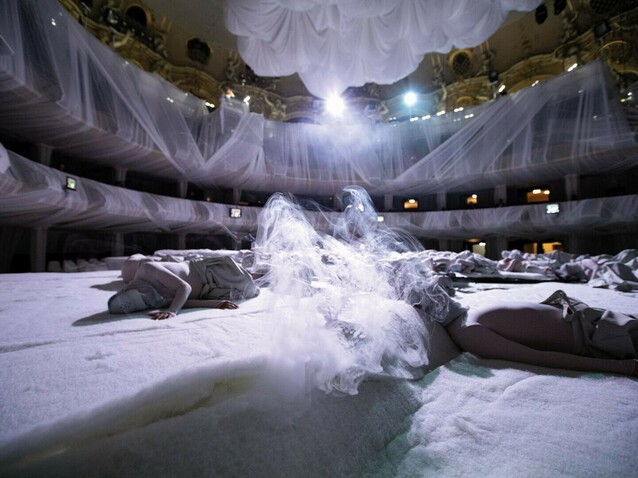 © Barbara Braun
© Barbara Braun
Intolleranza 1960 at the Komische Oper Berlin
The icy wind of history
The first production of the 2022/23 season at the Komische Oper Berlin, and at the same time the start of the new general management by Philip Bröking and Susanne Moser, could not have been more visually spectacular: The entire auditorium was covered with endless metres of white, semi-transparent tulle. You still remember the packaging artists Christo and Jeanne Claude? The wrapped Reichstag in Berlin in 1995 and more recently the Arc de Triomphe in Paris? The transformation of the auditorium of the Komische Oper by Márton Ágh's stage design is reminiscent of this. The stalls and the orchestra pit are largely covered with a platform, which in turn has ice-slab-like structures. Light fog floats over the post-apocalyptic landscape - the audience in the first two rows even receive tulle bibs to hang around their necks. The orchestra is relegated to the second tier and can thus create a quadraphonic stereo sound – an effect explicitly desired by the composer. A grandstand for the audience is set up on the actual stage. The tiers and the large chandelier are wrapped in the endless white tulle. Olaf Freese's lighting bathes the white, deserted, human-unfriendly landscape in cold light.
It is not only this first impression that evokes a "wow". It is also the dramaturgical approach for the opening of the new artistic direction. The perspective of a visit to the opera should change. Not only visually, but also in terms of content. After all, Intolleranza was highly controversial when it premiered at La Fenice in Venice sixty years ago in 1961. The scenic action, as Luigi Nono called his work, based on an idea by Angelo Maria Ripellino and supplemented here with a text by Carolin Emcke, was intended to shake up bourgeois society.
The plot revolves around the events in the life of a Migrant caught in a multitude of scenarios of modern capitalist society: exploitation of the working class, political arrest and torture, internment in a concentration camp and attempted escape in a derelict boat. Throughout, the Voice of History stands prominently by his side and tries to explain contexts and backgrounds. It is frightening how up-to-date these texts are, how the actors and places have changed, but the themes and problems have not.
Director Marco Štorman has his singers and the chorus enter the post-apocalyptic stage from different entrances in the auditorium. He turns Nono's originally conceived economic migrant into a refugee making him totally relevant to the current social and political landscape. The singers' allergorically implied characters perform off each other, there is no conventional plot. The libretto here is about the principles of injustice: As the Migrant, Sean Panikkar gives this character pathos and power at the same time; his melodious tenor laments and pleads for understanding and justice. Gloria Rehm is the Companion he meets on his journey, who tries to give him comfort with her silvery soprano. A Woman, mezzo-soprano Deniz Uzun, surrounds the two and gives hope to the young couple and their relationship. A character invented by director Marco Štorman for this purpose is that of the Angel of History – embodied by Berliner Ensemble member Julia Ritter is precisely this very earthly angel, anchoring the individual elements of the work in the here and now. The numerous male and female - also dressed and veiled entirely in white with costumes by Sara Schwartz and rehearsed by David Cavelius - comments on, threatens and comforts the Migrant, akin to a Greek Chorus.
Gabriel Feltz conducts the orchestra from the second tier, with Luigi Nono's shrill, discordant and tortured music really floating down onto the audience. After all, it was he who created the term Darmstadt School in 1958 to describe the music composed in the 1950s by him and Pierre Boulez, Bruno Maderna, Karlheinz Stockhausen. There is nothing melodic about this Nono’s music at yet it fits the concept perfectly.
Unfortunately, there are only six performances of the work, after which the auditorium of the Komische Oper has to be dismantled again to allow for normal opera operations. The prolonged applause for all involved shows that this experiment is definitely appreciated by the audience and that the relevance of opera - not only this work, but the genre itself - is confirmed in our society today.
Zenaida des Aubris
the 08 of October, 2022 | Print
Comments